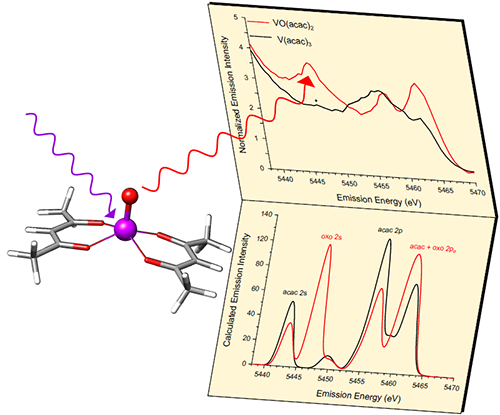X-RAY RUNS: Apply for Beamtime
2017 Nov 1 - Dec 21
2018 Feb 7 - Apr 3
2018 Proposal/BTR deadline: 12/1/17
2018 Apr 11 - Jun 4
2018 Proposal/BTR deadline: 2/1/18
Mechanistic studies of homo- and heterogeneous, as well as biological catalysis, often seek to understand changes in chemical speciation during turnover. Hard X-rays like those available at CHESS can provide an element-specific probe of geometric and electronic structure at or around an absorbing atom. Also, their lower attenuation at ambient pressure, compared to soft X-rays, makes them ideally suited to the study of molecules and materials in situ. Recently, vanadium Kβ X-ray emission spectroscopy (XES) performed using the dual-array valence emission spectrometer (DAVES) at C-line helped to create a fundamental understanding of perturbations in the valence electronic structure of vanadium ions in a range of oxidation states and chemical environments. Vanadium oxides are a key component of heterogeneous catalysts for oxidative alkane dehydrogenation, and vanadium-dependent metalloenzymes also perform a range of biochemical transformations. Thus, the development of vanadium K-shell X-ray spectroscopy as an element-selective tool for understanding changes in structure may help to advance mechanistic knowledge of key catalytic processes in both chemistry and biology.

The use of DAVES at C-line allowed better V Kβ XES spectra to be obtained in less time compared to previous measurements. The more idealized Rowland geometry and the new position-sensitive Pilatus Si pixel array detector ensured optimal spectrometer alignment throughout the 60 eV spectral range. Furthermore, a more rigorous background intensity correction could be performed, using a tightly windowed digital region of interest (ROI). The overall improvement in signal-to-noise achieved using this new spectrometer provided high quality spectra in the weak valence-to-core (VtC) region, where insight into metal-ligand interactions was obtained. The Kβ XES spectra of a set of vanadium oxides and molecular complexes were correlated to the corresponding X-ray absorption spectra, as well as density functional theory calculations. The insight obtained regarding both changes in vanadium-ligand interactions and diagnostic spectral features should be applicable to the in situ study of vanadium-containing catalytic systems.
Reference:
Rees JA, Wandzilak A, Maganas D, Wurster NI, Hugenbruch S, Kowalska JK, Pollock CJ, Lima FA, Finkelstein KD, DeBeer S, "Experimental and theoretical correlations between vanadium K-edge X-ray absorption and K[Formula: see text] emission spectra", J. Biol. Inorg. Chem. pp 1-13 (2016) DOI: 10.1007/s00775-016-1358-7
Submitted by: Julian Rees, Max Planck Institute for Chemical Energy Conversion & University of Washington
06/07/2016
